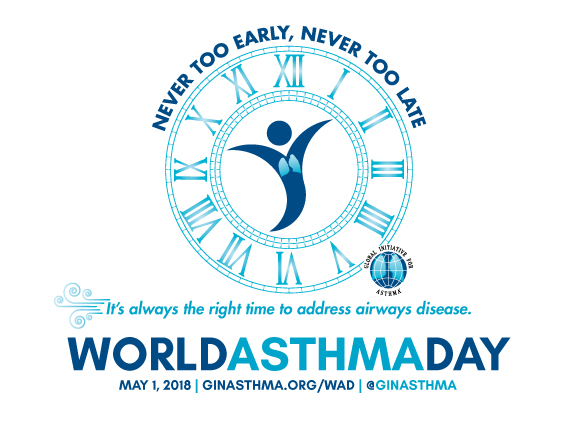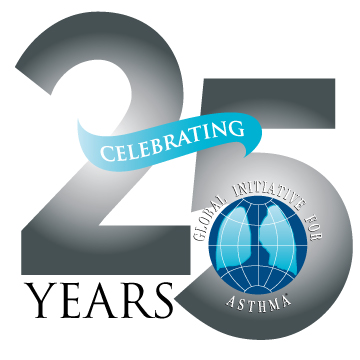Written by James Coker | Reporter, European Medical Journal | @EMJJamesCoker
![]()
 This year, World Asthma Day took place on 1st May 2018 during a period in which the prevalence of asthma is growing significantly. The World Health Organization (WHO) currently estimates that 235 million people around the world have the condition.1 The event, on its 20th anniversary, therefore was of paramount importance, and the messages spread by the campaign, which aims to raise awareness, care, and support for those affected by asthma, were once again disseminated far and wide across the world. To find out more about this year’s awareness day, the theme of which was ‘Never too early, never too late: It’s always the right time to address airways disease’, we spoke to GINA, a WHO collaborative organisation which organises the annual event. In addition to patient advocacy, the body also conducts substantial work assisting medical professionals involved in treating asthma, including the publication of various reports and guidance. This formed a large part of our discussion, including a thorough review of the recently published 2018 update of Global Strategy for Asthma Management and Prevention. Finally, GINA informed us about emerging themes and trends in asthma, and where research could be targeted in the future. The following information was provided by prominent members of GINA: Rebecca Decker, Program Director, in addition to insights from Dr Louis-Philippe Boulet, member of the Board of Directors and Prof Søren Pedersen, Chair of the Board of Directors, for the final two questions.
This year, World Asthma Day took place on 1st May 2018 during a period in which the prevalence of asthma is growing significantly. The World Health Organization (WHO) currently estimates that 235 million people around the world have the condition.1 The event, on its 20th anniversary, therefore was of paramount importance, and the messages spread by the campaign, which aims to raise awareness, care, and support for those affected by asthma, were once again disseminated far and wide across the world. To find out more about this year’s awareness day, the theme of which was ‘Never too early, never too late: It’s always the right time to address airways disease’, we spoke to GINA, a WHO collaborative organisation which organises the annual event. In addition to patient advocacy, the body also conducts substantial work assisting medical professionals involved in treating asthma, including the publication of various reports and guidance. This formed a large part of our discussion, including a thorough review of the recently published 2018 update of Global Strategy for Asthma Management and Prevention. Finally, GINA informed us about emerging themes and trends in asthma, and where research could be targeted in the future. The following information was provided by prominent members of GINA: Rebecca Decker, Program Director, in addition to insights from Dr Louis-Philippe Boulet, member of the Board of Directors and Prof Søren Pedersen, Chair of the Board of Directors, for the final two questions.
Q: Could you describe what have been the most memorable World Asthma Day initiatives over the years and what the main outcomes of these were?
A: Some of the most memorable and impactful events are hosted in geographies with highly limited resources. We see grass roots efforts (such as printed signs and table top displays) offering free asthma screenings that really break down barriers to treatment. The global asthma community is highly dedicated to improving diagnoses, regardless of access or lack of access to advanced tools and resources.
Q: How does GINA collaborate with other asthma organisations around the world to ensure the message is consistent and spread to the highest number of people possible?
A: We are fortunate to have a networked worldwide community of asthma advocates, called the GINA Assembly. The Assembly consists of asthma healthcare providers from over 60 countries that are responsible for the dissemination of GINA strategy in their respective countries and with their local organisations. We meet with the GINA Assembly twice per year (at the American Thoracic Society [ATS] and European Respiratory Society [ERS] Congresses) to provide updates and answer clinical challenge questions they may have.
Q: What was the main theme of this year’s event? Why was this chosen?
A: The theme of World Asthma Day 2018 is ‘Never too early, never too late: It’s always the right time to address airways disease.’ This theme will also be used for World COPD Day in November. We wanted to express the need for increased global education in all airways diseases, regardless of age of presentation.
Q: GINA publishes a number of reports and guidance regarding the treatment, management, and prevention of asthma. Could you briefly explain the process of how the content of these reports are decided and how they are then created to ensure they are as impactful as possible?
A: For each meeting of the GINA Science Committee, a rolling PubMed search is performed covering approximately 18 months, using filters established by the committee: 1) asthma, all fields, all ages, only items with abstracts, clinical trial, human; and 2) asthma and meta-analysis, all fields, all ages, only items with abstracts, human. The ‘clinical trial’ publication type includes not only conventional randomised controlled trials, but also pragmatic, real-life, and observational studies. The respiratory community is also invited to submit to the Program Director any other peer-reviewed publications that they believe should be considered, provided an abstract and the full paper are submitted in (or translated into) English; however, because of the comprehensive process for literature review, such ad hoc submissions have rarely resulted in substantial changes to the report.
After initial screening by the Editorial Assistant and Chair of the Science Committee, each publication identified by the above search is reviewed for relevance and quality by members of the Science Committee. Each publication is allocated to at least two committee members, but all members receive a copy of all of the abstracts and have the opportunity to provide comments. Members evaluate the abstract and, by his/her judgment, the full publication, and answer written questions about whether the scientific data impact on GINA recommendations, and if so, what specific changes should be made. A list of all publications reviewed by the committee is posted on the GINA website.
During committee meetings, each publication that was assessed by at least one member to potentially impact on the GINA report is discussed. Decisions to modify the report or its references are made by consensus by the full committee, or, if necessary, by an open vote of the full committee; members recuse themselves from decisions with which they have a conflict of interest. The committee makes recommendations for therapies that have been approved for asthma by at least one regulatory agency, but decisions are based on the best available peer-reviewed evidence and not on labelling directives from government regulators. In 2009, after carrying out two sample reviews using the GRADE system, GINA decided not to adopt this methodology for its general processes because of the major resource challenges that it would present. This decision also reflected that, unique among evidence-based recommendations in asthma, and most other therapeutic areas, GINA conducts an ongoing twice-yearly update of the evidence base for its recommendations. As with all previous GINA reports, levels of evidence are assigned to management recommendations where appropriate. A description of the current criteria is found in Table A. Annual updates of the Global Strategy for Asthma Management and Prevention are based on evaluation of publications from July 1st of the previous year through to June 30th of the year in which the update was completed.
Q: Please provide an overview of the recently published 2018 update of Global Strategy for Asthma Management and Prevention. What were the updates included and what effect do you hope they will have?
A: The updates are itemised below. We hope that the updates, as always, will assist practitioners around the world with the daily challenges presented by asthma diagnosis and management.
- Assessment of asthma (Box 2-2, p. 29): The concept of ‘independent’ risk factors for exacerbations has been clarified. These are factors that, if present, increase the risk of exacerbations even if the patient has few symptoms. They are identified from analyses that have adjusted the analysis of risk of exacerbations for a measure of symptom control. In Box 2-2, higher bronchodilator reversibility has been added as an additional independent risk factor for exacerbations in both adults and children. Additional risk factors for developing persistent airflow limitation have been added: pre-term birth, low birth weight, and greater infant weight gain.
- Fractional exhaled nitric oxide (FENO): This test is becoming more widely available in some countries. All sections about FENO throughout the report have been reviewed and the text edited for clarity and to take new data into account. These sections include diagnosis (p. 20), alternative strategies for adjusting asthma treatment (p. 38), recommendations about initial controller treatment (p. 42), management of asthma in pregnancy (p. 68), and prediction of asthma in children (p. 104). The section on FENO-guided treatment (p. 38) has been updated to reflect the results of new meta-analyses that separately analysed studies in which the control algorithm was reasonably close to current guidelines-based treatment, and therefore provided a clinically relevant comparator. In studies involving children and young adults, these analyses showed that FENO-guided treatment was associated with significantly fewer exacerbations and lower exacerbation rate than treatment based on current guidelines. For adults, no significant difference was seen with FENO-guided treatment compared with treatment based on current guidelines. Further studies are needed to identify the populations most likely to benefit from FENO-guided treatment, and the optimal frequency of monitoring.
- Step 3–4 treatment (p. 47): The text has been updated to include the outcomes of three US Food and Drug Administration long-acting ß2-agonist (LABA) safety studies in adults, adolescents and children, in which the combination of inhaled corticosteroid (ICS)/LABA was compared with the same dose of ICS.
- Step 5 treatment (p. 48): Benralizumab (monoclonal anti-IL-5 receptor) has been added to the existing Type 2-targeted biologics for severe eosinophilic asthma. The age ranges approved for Type 2-targeted biologics have been clarified.
- Allergen immunotherapy (p. 52): A qualifier has been added that responses may be specific to the extracts and regimens used.
- Management of allergic rhinitis (p. 66): Treatment with nasal corticosteroids is associated with improved asthma outcomes only in patients who are not also receiving ICS.
- A new section has been added about perimenstrual asthma (catamenial asthma) (p. 69).
- Follow-up after acute asthma presentation (p. 81) and Box 4-3 (p. 80): Advice about reliever inhalers has been clarified: patients should be advised to take their reliever only when needed, rather than regularly.
- Asthma-chronic obstructive pulmonary disease (COPD) overlap (Chapter 5): Examples have been added of different phenotypes amongst patients with features of both asthma and COPD (p. 91). The interim safety recommendation for ICS to be included in treatment for patients with COPD and a history of asthma is supported by a well-conducted case-control study (p. 96).
- Preschool children: Step 3 treatment (p. 110): In a multicentre study, blood eosinophils and atopy predicted greater short-term response to moderate dose ICS than to leukotriene receptor antagonists. The relative cost of different treatment options in some countries may be relevant to controller choices for children.
- Prevention of asthma (Chapter 7): The section on nutrition has been reorganised to distinguish between evidence about dietary factors and supplements, and new studies of supplementation with fish oil and long-chain polyunsaturated fatty acids during pregnancy have been added. Evidence for protection against wheeze, asthma, or atopy is still inconclusive.
- Corrections: The range of Asthma Control Test for ‘not-well-controlled asthma’ has been corrected to 16–19 years of age (p. 28); Box 6-6 (low ICS doses in children 5 years and younger): Several entries in this table have been corrected for consistency with the relevant product information in this age group.
Q: What methods does GINA use to disseminate its various reports and findings to healthcare professionals around the world? How can healthcare professionals best access this information?
A: The GINA reports are open access, free downloads from the GINA website. If printed copies are requested, there is a printing and shipping fee associated with this.
Q: What will be the main aims and focus of the soon to be published ‘GINA Patient Guide: You Can Control Your Asthma’?
A: We have recently added a new resource to the GINA Website called the GINA Implementation Toolbox. The toolbox contains a number of impactful tools to assist practitioners with diagnosis and management, patient education, discharge, and follow-up. These tools were developed by members of the GINA Dissemination and Implementation Committee and the GINA Science Committee. The Patient Guide will be one more resource in the toolbox for improving provider-patient discussions aimed at improved asthma control.
Q: What have been the trends of asthma prevalence worldwide that GINA have observed in recent years? Are there any particular areas of concern?
Louis-Philippe Boulet:
Although the observed increase in the prevalence worldwide observed in the last decade appears to have plateaued in industrialised countries, it seems to have further increased in developing countries, possibly due to the adoption of a more Western lifestyle or other factors (environmental etc.). Recent reports indicate that asthma is the most prevalent chronic respiratory disease worldwide.2 Unfortunately, we have evidence that although asthma may sometimes be over-diagnosed, it mostly seems largely under-diagnosed worldwide.
Søren Pedersen:
Asthma affects between 1% and 18% of the population in different countries, equating to an estimated 334 million people worldwide. Globally, the prevalence of asthma increasing, but the mortality rate due to the condition is decreasing, with a reduction of 26.7% worldwide during the last 25 years. The reduction in asthma-related mortality may be attributed to the generation of guidelines, both global and national/regional, to improve diagnosis and standardise treatment strategies. However, asthma still presents a significant socioeconomic burden globally, accounting for 26.2 million disability-adjusted life years in 2015.
‘Mild asthma’ accounts for 50–75% of patients with asthma. Severe exacerbations in mild asthma represents 30–40% of all asthma exacerbations requiring emergency care. This questions whether the term mild asthma is appropriate. Despite the reduction in asthma-related mortality and the introduction of treatment guidelines, inadequate asthma control is present in at least half of asthmatic patients in Europe. This is of great concern. Most patients with asthma require effective and ongoing treatment for improving symptom control and preventing future risks such as impairment of lifestyle, exacerbations, and hospitalisation. This is not the case in 2018. Initiatives to improve this are needed.
Q: What areas of research into the causes of asthma require emphasis in the coming years? Are GINA involved in any initiatives in this respect?
Louis-Philippe Boulet:
Among the main fields of research on asthma, we need more data on how to better prevent this disease. We also need more research on how to better determine its phenotype or endotype (underlying mechanisms) to offer a more adequately targeted treatment, particularly for those with severe asthma. Data are required on how to optimally manage asthma in specific sub-populations such as the elderly, obese patients, smoking asthmatics, and athletes, for example. Finally, research on how to improve and adapt asthma educational interventions to patients and their co or self-management skills are welcome, as well as about proper use and adherence to medication.
Søren Pedersen:
Asthma is a heterogenous disease with a complex pathogenesis involving an interaction of genetic, environmental, and immune factors. Research on the causes of asthma, and preventing or modifying the development of the condition includes all of these areas. So far none of the studies have been markedly successful.
REFERENCES
- World Health Organization. Asthma: Key Facts. 2017. Available at: http://www.who.int/en/news-room/fact-sheets/detail/asthma. Last accessed: 8 May 2018.
- GBD 2015 Chronic Respiratory Disease Collaborators. Global, regional, and national deaths, prevalence, disability-adjusted life years, and years lived with disability for chronic obstructive pulmonary disease and asthma, 1990–2015: A systematic analysis for the Global Burden of Disease Study 2015. Lancet. 2017;5(9):691-706.

To access the website of GINA, click here.










